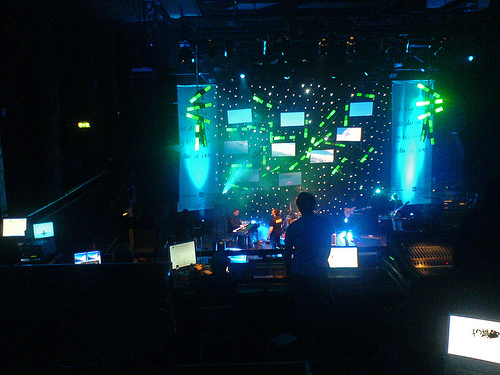Yesterday evening, I attended a video programme at FIFA (Festival Internationale du Film sur l’Art). This solid programme was curated by Nicole Gingras, one of my favourite video curators around, and included a few artists I am aware of and enjoy very much (Daniel Cockburn, Nelly-Ève Rajotte, Paul Landon), with some work by artists whose work I have not yet had the pleasure of seeing (Mario Côté).
Among the pieces I enjoyed was “Peindre la Peinture”, a video by Katherine Liberovskaya, with an original score by Phill Niblock, and the participation of painter Graham Cantieni. The premise of the video was simple: a camera was attached to the painter’s wrist as he painted. The video was hypnotic, a rhythm developing as we follow the progress of the painter’s gesture: dipping the brush, sweeping it across the canvas, dipping the brush in the paint again. The piece was long, by current hip video art standards, at just over fifteen minutes. Though the constant swooping did make me a little dizzy, I think the length was required to achieve the trance-like effect it eventually induced; and relaxing completely into the piece’s rhythm caused me to think how similar the feeling I was having was to the feeling one has when creating – a concentration and intensity that comes with the act of execution, once past the euphoria of generating the idea.
I thought about how at first glance, painting might seem to be a series of mysterious and complicated gestures – the magic is all in the wrist and hand, right? Perhaps this is true, for certain kinds of painting, but in the case of this video it was represented as an endlessly repeating, broad gesture. I liked this about it, and it led me to thinking about how much obsessive repetition plays a part in all art making – performers repeating lines and gestures, video loops, sculptures based on molding and casting. Implicitly, repetition is about perfecting something – a perfect image, a perfect experience, a perfect object. The execution of a style becomes an artist’s second nature, perfected through repetition. I think particularly of paintings by Roman Opalka and Agnes Martin, which are very different, but still repetitive, comtemplative work. Their painterly gestures became repetitive in the extreme.
Perhaps finally, repetition becomes a trusted technique because it is comforting. It is rule-based, it is part of a quest for perfection and the regulations it imposes enable us to focus on a singular path of attaining perfection. Perhaps it seems simple, and even ridiculous, to strive for this. It is definitely futile – however many times something is repeated, it would be difficult, if not impossible, to say that you have truly perfected a thing – be it painting a line, delivering a line of dialogue, or popping a wheelie. Perhaps I’m forcing a point when I say the end goal of all this repetition is perfection – it’s an end point that we actually don’t want to reach, since the results of endless attempts are so beautiful in and of themselves. Or as Mark C. Taylor wrote in the catalogue for the exhibition at the Guggenheim Museum, “Singular Forms (Sometimes Repeated): Art from 1951 to the Present“: “There is no end to art because the gap in which it emerges can never be closed.”
